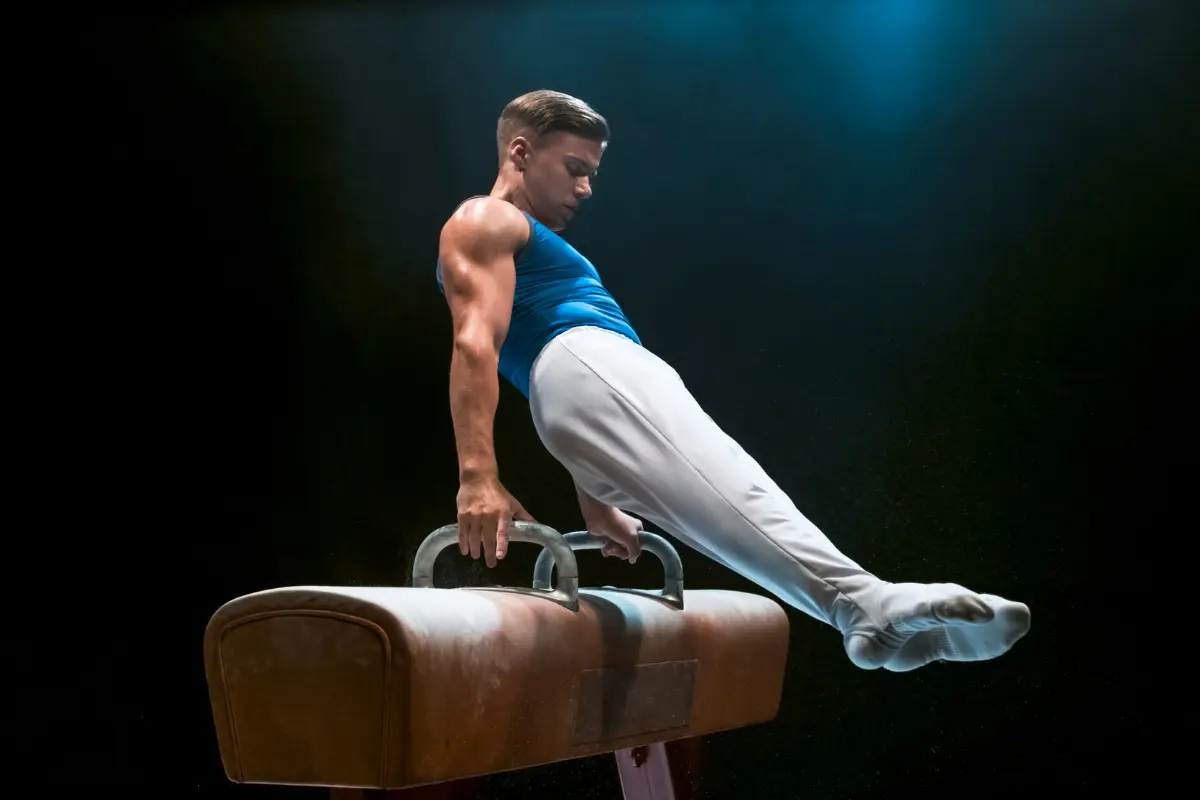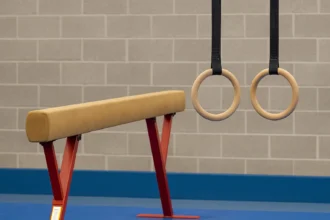The pommel horse is one of the six men’s artistic gymnastics (MAG) apparatuses and perhaps the most misunderstood. To the untrained eye, it may look like a gymnast is simply swinging their legs in circles. In reality, it is a relentless test of rhythm, body control, and technical precision unlike anything else in gymnastics.
What Is the Pommel Horse?
The pommel horse is a padded apparatus covered in synthetic leather. A regulation horse is 160 cm long, 35 cm wide at thThe pommel horse is a padded apparatus covered in synthetic leather. A regulation horse measures 160 cm long, 35 cm wide at the top, and stands 115 cm high. The two pommels, or handles, rise about 12 cm above the surface, and their distance can be adjusted to between 40–45 cm apart to fit the gymnast. Surrounding mats are 10 cm thick, offering safety but doing nothing to make the apparatus itself more forgiving.
Unlike other MAG events, the pommel horse is unique because:
- There are no static holds or pauses (unlike rings or parallel bars).
- Legs must remain in constant motion, often extended and together.
- Technique is valued over power, making precision absolutely critical.
Gymnasts swing their legs around the horse in circles, scissors, and travels, using only their hands for support.
Core Skills on Pommel Horse
At its foundation, pommel horse routines are built on a handful of essential skills:
- Scissors (EG I): Typically placed at the start of a routine. Scissors are single-leg pendulum-like swings that generate momentum for circle work. Variations may include turns, direction changes, or transitions into handstand.
- Circles & flairs (EG II): The bread and butter of pommel horse. Circles involve both legs swinging together in a tight arc, while flairs (Thomas flairs) use a straddle position with the hips lifted higher, creating a “floating” look and allowing more freedom to change direction.
- Travels (EG III): Circles performed while moving along the length or width of the horse. The Magyar (forward travel) and Sivado (backward travel) are classics. At the elite level, gymnasts chain multiple travels with spindles (turns) or Russians to show full mastery.
- Dismounts (EG IV): Routines end with a controlled handstand or traveling circle that finishes cleanly on the floor—always without breaking swing.
Every pommel horse routine must flow without hesitation; the dismount is simply the final continuation of swing.
Source: thegymnasticsauthority.com, Inside Gymnastics Magazine
How a Pommel Horse Routine Is Built
Under the FIG Code of Points (2025–2028 cycle), pommel horse routines are judged with a structure that eUnder the FIG Code of Points (2025–2028 cycle), pommel horse routines are judged with an emphasis on rhythm, variety, and high-value skill composition.
- Difficulty Score (D-score): Only the gymnast’s best eight elements count toward difficulty (down from ten in the previous cycle), making execution and smart construction more important than ever.
- Element Groups (EGs): Routines must include skills from four families:
- EG I: Single-leg swings and scissors
- EG II: Circles and flairs
- EG III: Travel elements
- EG IV: Dismounts
A key update in this cycle is that dismounts now count as their own element group, with EG value equal to their difficulty letter. For example, a D dismount not only scores as a D element (0.4) but also adds 0.4 in EG credit, essentially scoring twice.
Judges have also clarified certain gray areas. For example, during scissors, if a gymnast supports themselves with a leg before completing the swing, the element isn’t recognized and a neutral deduction is applied. Small brushes or light arm bends may only cost a few tenths, but relying on a leg for support voids the skill entirely.
What Judges Look For
A good pommel horse routine is more than just staying on. Judges expect:
- Coverage and composition: Skills must use all sections of the horse—the middle, both ends, and across the pommels. Circles, flairs, scissors, and travels should connect seamlessly in continuous rhythm.
- Line and amplitude: Hips rise high above the handles, legs stay extended and tight together (or purposefully straddled in flairs), toes remain pointed, and tempo is consistent.
- Precision in support: Circles must pass through proper side and cross-support positions. Errors in orientation can cause deductions or even downgrade the skill.
- A convincing finish: The dismount should flow naturally out of swing, often a travel into handstand with turn. With the new Code, a strong dismount pays off in both difficulty value and EG credit.
A Smart Beginner Progression (Coach-Approved)
Nobody learns pommel horse by jumping on the apparatus and swinging away. Progression is broken into small, coachable steps that develop rhythm, shapes, and confidence over time.
1. Foundations Off the Horse
Before touching the horse, gymnasts drill hollow and arch shapes, shoulder opening, and wrist conditioning. Parallettes and rails teach straight-arm pressure—supporting bodyweight without shrugging. A tall, locked-out shoulder becomes second nature here.
2. Mushroom Circles
The mushroom trainer is the entry point. Athletes build circles gradually—quarter, half, then full. Later, straddle circles develop into flairs. Coaches emphasize neutral head, tall shoulders, and torso lean in the travel direction to keep hips centered.
3. Leg Cuts and Scissors
Next come leg cuts (swinging one leg over the trainer from support), which teach coordination and weight shift. Then come true scissors on pommel trainers. Scissor-to-handstand drills are especially valuable for learning dismount control.
4. Circles on the Horse
Once consistent, gymnasts transition to circles on the actual horse, usually starting between the pommels where support is widest. Visual markers and spotting sticks keep circles centered. Focus: even rhythm, tall support, and hips high.
5. Travels and Turns
Forward (Magyar) and backward (Sivado) travels introduce movement across the horse while maintaining tempo. Next come spindles, where gymnasts rotate their body during circles without breaking rhythm. Coaches slow things down if tempo falters—form comes before distance.
6. Crafting the Dismount
Beginners start with simple handstand swings, then progress to higher-valued dismounts. A strong finish matters twice: once for difficulty, and once for EG credit under the Code.
Safety & Setup Notes
- Keep the horse’s surface chalked, not slick, for controlled glide.
- Always use 10 cm competition mats and spotting for new skills.
- Adjust pommel spacing (40–45 cm) to match shoulder width; beginners often prefer them closer for stability.
Why It’s Called the “Most Technical” Event
On pommel horse, strength alone won’t save you. There’s no pause, no reset, no “muscling through.” Every swing depends on flawless rhythm and body alignment. Even tiny errors—separating legs, bending knees, dropping hips—are magnified by the horse’s narrow, curved surface.
That’s why the pommel horse is both a nightmare for many gymnasts and a crown jewel for those who master it. It is the ultimate test of precision, rhythm, and technique in men’s artistic gymnastics.













